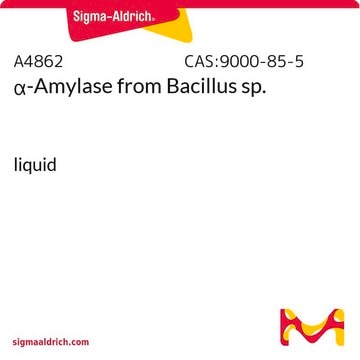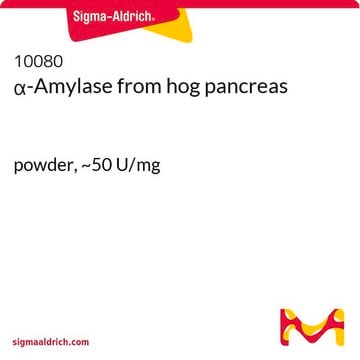This product is soluble in water. No additional calcium is required. For specific applications it may also be prepared in typical sodium or potassium phosphate buffer solutions.
10069
α-Amylase from Bacillus sp.
powder, yellow-brown, ~380 U/mg
Seleccione un Tamaño
US$ 155,00
Fecha estimada de envío01 de junio de 2025
Seleccione un Tamaño
About This Item
US$ 155,00
Fecha estimada de envío01 de junio de 2025
Productos recomendados
origen biológico
Bacillus sp.
Formulario
powder
actividad específica
~380 U/mg
características de los productos alternativos más sostenibles
Waste Prevention
Design for Energy Efficiency
Learn more about the Principles of Green Chemistry.
sustainability
Greener Alternative Product
color
yellow-brown
categoría alternativa más sostenible
, Enabling
temp. de almacenamiento
2-8°C
¿Está buscando productos similares? Visita Guía de comparación de productos
Categorías relacionadas
Descripción general
Aplicación
- as a dispersal enzyme to test degradation of S. aureus biofilms[2],
- in the enzymatic hydrolysis of tapioca starch[3]
- in the enzymolysis of plant-based native and the amorphous granular starches[4]
Acciones bioquímicas o fisiológicas
Definición de unidad
Palabra de señalización
Danger
Frases de peligro
Consejos de prudencia
Clasificaciones de peligro
Resp. Sens. 1
Código de clase de almacenamiento
11 - Combustible Solids
Clase de riesgo para el agua (WGK)
WGK 1
Punto de inflamabilidad (°F)
Not applicable
Punto de inflamabilidad (°C)
Not applicable
Equipo de protección personal
dust mask type N95 (US), Eyeshields, Faceshields, Gloves
Elija entre una de las versiones más recientes:
¿Ya tiene este producto?
Encuentre la documentación para los productos que ha comprado recientemente en la Biblioteca de documentos.
Los clientes también vieron
-
In which solution I should to dissolve the alfa amylase? should had ca+2? (for starch degradation)
1 answer-
Helpful?
-
Active Filters
Nuestro equipo de científicos tiene experiencia en todas las áreas de investigación: Ciencias de la vida, Ciencia de los materiales, Síntesis química, Cromatografía, Analítica y muchas otras.
Póngase en contacto con el Servicio técnico












